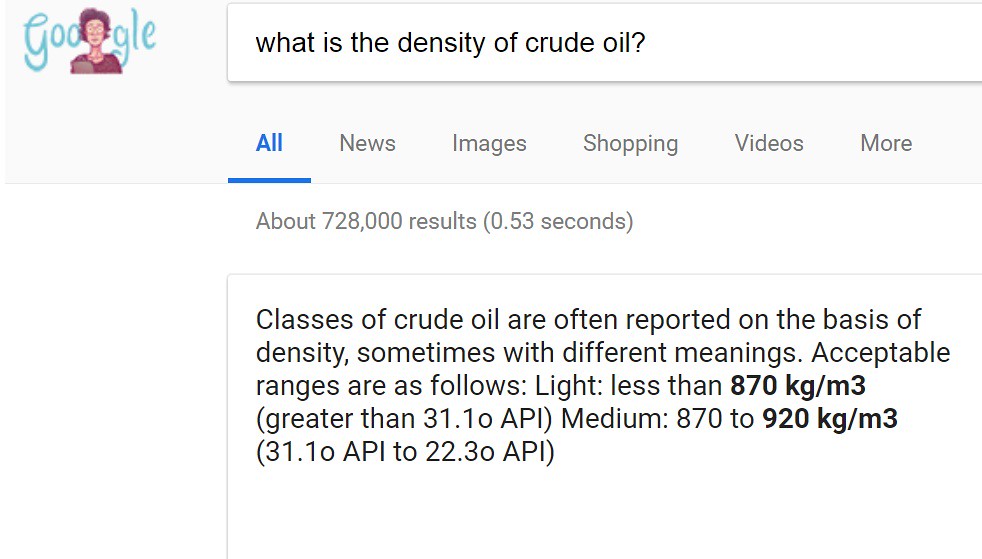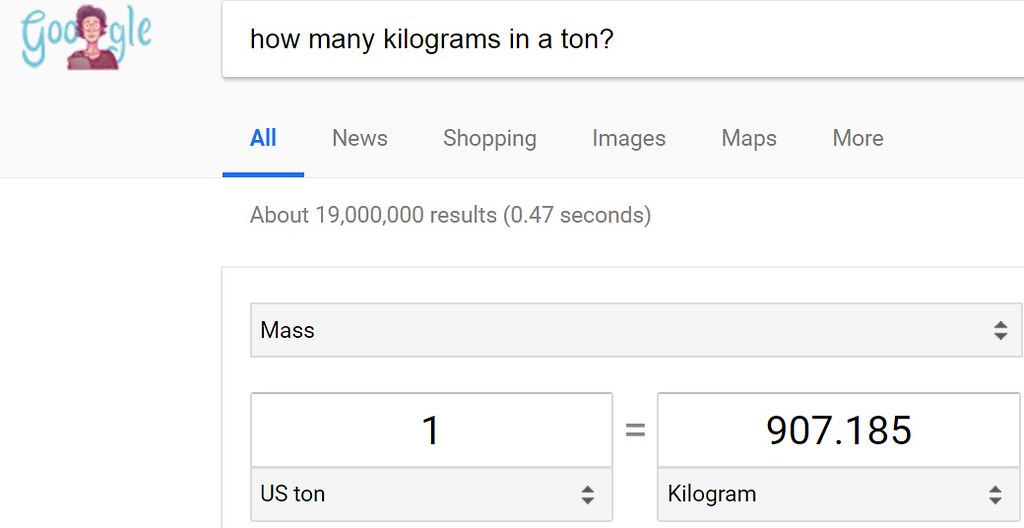 |
| Source: Acclaim Images |
Back in January, an oil spill occurred off the coast of China. One account reported the oil spill to be largest in history. Whenever an oil spill is reported, the number is stated and rarely cast into perspective. Which makes the visualization of such a disaster very difficult to achieve. In order to really understand, an analysis needs to be carried out. Below I explore the oil spill in China using dimensional analysis (and past blog posts). There are the following steps in the analysis:
1) Convert the weight of oil spilled into a volume using the density of crude oil
2) Compare the calculated volume to a previous oil spill in history
3) Put the volume into perspective using a known volume as a metric
How Large Was The Spill?
The answer to the question of size is difficult due to the continuous diffusion of oil over time after a spill occurs. What is reported is usually the amount (in weight or volume) of oil. In an article from 'The New York Times' titled "Huge Oil Spill Spreads in East China Sea, Stirring Environmental Fears" the author states the amount spilled as follows:
HONG KONG — An oil spill from an Iranian tanker that sank in the East China Sea is rapidly spreading, officials said Tuesday, alarming environmentalists about the threat to sea and bird life in the waterway.The tanker, the Sanchi, was carrying 136,000 tons of highly flammable fuel oil when it crashed into a freighter on Jan. 6. On Sunday, the Sanchi sank after a huge blast sent up a great plume of black smoke and set the surface of the water on fire, China Central Television said.The bodies of three crew members have been recovered, and the remaining 29 were presumed dead, the Iranian government said. Thirty Iranians and two Bangladeshis were believed to have died.The oil slicks from the sunken tanker were growing in size, China’s State Oceanic Administration said Tuesday. There are now two huge slicks covering 52 square miles, compared with just four square miles the previous day. Strong winds were pushing the spill toward Japan, away from China, and it was now less than 200 miles from Naha, Japan.
Wow! That is crazy. Although, I find the number of tons of oil spilled confusing. Different media reports state statistics differently. Some use 'cubic feet of oil', while others use 'tons', yet others use gallons. I wish that there would be a standard set by the Associated Press for readers. A comparison would be much easier with a standard unit set for large oil spills around the world.
Since that is not the case, dimensional analysis can be used to get us to a standard for comparison to other spills reported on this site. The amount of oil spilled off the coast of China was stated in 'tons' -- which is a weight. In order to get a volume out of units of weight -- a 'unit conversion' is necessary.
The unit conversion factor is specific to each chemical. Every chemical has a unique volume associated with a given amount of weight. In other words, the 'density' of a chemical species is the amount of weight specified for a given volume. The units can vary but are usually stated as 'grams/milliliters' or 'kilograms/cubic meters'. If the following question was typed into a search engine regarding the 'density' of oil: What is the density of Oil? -- the result shown below would appear at the top of the screen:
The result of the search above indicates that the density of crude oil is actually a range. Crude oil is a composition of varying chains of hydrocarbons. Hydrocarbons are molecules in the shape of 'chains' which contain mostly elements 'hydrogen' and 'carbon.' Crude oil is a mixture of chemicals and therefore the density can vary. For the purpose of this analysis, the value of 900 kilograms/cubic meter will be used -- which is in the stated range above.
Having a value of density allows the conversion of a 'weight' to a 'volume' as follows. Starting with the weight of the oil spill from the excerpt above -- 136,000 tons, a change of notation is useful for conciseness. Below, the weight is expressed in scientific notation:
Scientific notation is a way to handle large numbers in calculations rather than writing out large numbers in long form. Before the conversion from a weight to a volume of oil is possible, a direct unit conversion is necessary first. What? Yes, the density is expressed in units of 'kilogram/cubic-meter'. The stated weight of the oil spill is in units of 'tons'. Therefore, a direct conversion is needed from 'ton' to 'kilogram' before proceeding to convert to a volume.
If the following question is typed into Google: How many kilograms in a ton? The following appears below:
The result of the query shows that there are 907.185 kilograms in a single ton. With the conversion value in hand, the conversion from 'ton' to 'kilogram' is shown below:
Now that the unit of weight is consistent with the units contained in the density of crude oil, the volume can be determined of crude oil from the weight as follows:
The result of the calculation indicates that a total of 137,000 cubic meters was released during the oil spill. In order to put this result in perspective with other calculations on this blog, the conversion from units of 'cubic meters' to 'gallons' is necessary. If Google is consulted with the following question: How many gallons in a cubic meter? The following result is shown below:
There are 264.172 gallons in a single cubic meter. The conversion from units of 'cubic meters' to 'gallons' is now possible and shown below:
The oil spill in China resulted in a total of 35.7 million gallons of oil being deposited into the ocean. Wow! In the past blog posts on large volume spills (which can be found here), a comparison was made to previous spills. If the largest oil spill in history -- Deepwater Horizon Oil Spill -- is used as a metric for comparison, the following analyses can be obtained shown below:
The two calculations yield different numbers with different meanings. First, the Deepwater Horizon Oil spill in the gulf of Mexico contained a total of 210,000,000 gallons of oil (210 million). In the first calculation, the result indicates that the oil spill in China was small compared to the Deepwater Horizon Oil spill. In comparison, there would be 588 equivalent volumes of oil (China) to a single volume of oil contained in the Deepwater Horizon Oil spill.
The second calculation above indicates shows that the volume of the oil spilled in China is roughly 17% of volume spilled during the Deepwater Horizon Oil spill. Given that these two different numbers calculated above are difficult to visualize, there is a need to cast them into a visual perspective. Below, I show that the volume can easily be put into perspective using a metric from a past blog post.
Magnitude of volume
The magnitude of the volume was calculated above and compared to the previously reported largest oil spill in history -- Deepwater Horizon Oil spill. Turns out that the Deepwater Horizon Oil spill is still the largest oil spill in history. The news media accounts that reported the oil spill in China to be the largest in history were incorrect. The calculations indicated that the oil spill in China was small in comparison to the Deepwater Horizon Oil spill. The total volume of oil spilled was 35.7 million gallons of oil.
In order to visualize how large 35.7 million gallons of water is exactly or approximately, a metric is needed to cast the volume into perspective. In the past, a common metric to compare large volumes of liquid has been to choose the "World's Largest Swimming Pool" in Chile shown below:
 |
| Source: Huffington Post |
The swimming pool shown above holds around 66 million gallons. Which makes the volume of oil spilled in China easily understandable. The total volume of oil spilled in China could fill just over half of the swimming pool above. A person can easily visualize the amount of oil spilled in comparison to the volume shown above.
Conclusion...
News accounts can vary with regard to statistics which are reported. Further, statistics can be misleading. Fortunately, the above analysis allows each of us to cast any number into perspective. The results of the calculations show that the oil spill in China was not the largest oil spill in history. The recent oil spill was a tragedy, but at least the spill was smaller in comparison to other past oil spills. Compared to the largest oil spill in history -- Deepwater Horizon Oil spill -- the spill was 1/588 the size -- Or 17%. The spill was more comparable to the Exxon Valdez Oil spill which was around 20 million gallons of oil. Regardless, using the analysis above and visual metric provided, the magnitude of the oil spill is now easily understandable.
More blog posts can be found here.








No comments:
Post a Comment